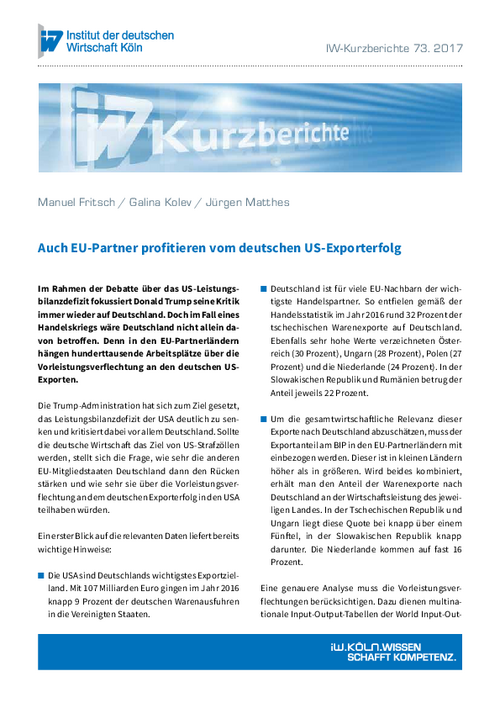In the debate of the US current account deficit, Donald Trump focuses his criticism to a large extent on Germany. But in the case of a trade war it would not affect Germany alone. Due to intermediate input linkages, hundreds of thousands of jobs in the EU partner countries depend on the success of German exports to the US.

EU Partners benefit from Germany's US export success
IW-Kurzbericht

In the debate of the US current account deficit, Donald Trump focuses his criticism to a large extent on Germany. But in the case of a trade war it would not affect Germany alone. Due to intermediate input linkages, hundreds of thousands of jobs in the EU partner countries depend on the success of German exports to the US.
Embed Code
<div id="highcharts-anaxofy"><script src="//cloud.highcharts.com/inject/anaxofy" defer="defer"></script></div>
The Trump Administration has set itself the goal of significantly lowering the US current account deficit and focuses its criticism mainly on Germany. Should the US impose punitive tariffs on those products that the German economy is particularly strong in, the question then is: To what extent do other EU member states participate in Germany’s US export and would therefore strengthen Germany’s backing in their own interest?
A first look at the relevant data already provides some key indicators:
- The US is Germany’s most important target export country. Nearly 9 per cent of German goods exports, of a value of 107 billion euros, went to the United States in 2016.
- Germany is the most important trading partner for many EU countries. For example, around 32 per cent of Czech goods exports go to Germany (as of 2016). Likewise, similarly high figures are recorded for Austria (30 per cent), Hungary (28 per cent), Poland (27 per cent), and the Netherlands (24 per cent). For Slovakia and Romania, the share amounts to 22 per cent respectively.
- In order to evaluate the overall economic relevance of these exports to Germany, exports as a share of GDP in the EU partner countries have to be taken into account. Naturally, in smaller countries this figure is higher than in larger ones. When the two figures are combined, the result is the share of goods exports to Germany in the economic output of the individual country. In the Czech Republic and Hungary, this figure amounts to just over one-fifth; in Slovakia, just under that. For the Netherlands it is almost 16 per cent.
A more precise analysis must take European intermediate input linkages into account. For this purpose, we refer to the international input-output tables of the World Input Output Database (WIOD), which provide data through 2014. These can be used to calculate how much production, value added, and employment in the individual EU member states is generated by the fact that intermediate inputs (in the form of goods and services) flow to Germany and from there are indirectly exported to the US. According to the usual assumption of proportionality, value added and employment are spread over demand similarly as the production value. Gaps in the data supplied by Eurostat are approximated.
This leads to the following findings:
- In 2014, a total of nearly 40 billion euros in production value and almost 14 billion euros in value added were indirectly generated in Germany’s EU partner countries via intermediate inputs that went into German exports to the USA.
- Overall, in 2014 over 253,000 jobs in the EU partner countries were dependent on German exports to the USA. Since 2000, this figure has grown by approximately 16 per cent. The German US exports of the automotive industry alone ensured the employment of nearly 110,000 employees in other EU countries via this indirect channel.
- The number of jobs indirectly dependent on German US exports is especially high in several of Germany’s neighbouring countries (Figure): In Italy, the Czech Republic, France, and the Netherlands, it ranges between 22,000 and nearly 26,000.
- In Poland, almost 45,000 jobs were dependent on German US exports. This is almost one-third of the employees who are either directly dependent on the Polish US exports, or indirectly on the indirect channel via German US exports to the USA.
Thus it is clear that several EU partners do benefit to a considerable degree from Germany’s US export success. Moreover, naturally their own interests are at stake, as US punitive tariffs directed at German product specialisation would adversely affect part of their own exports – and along with them, domestic employment.

Manuel Fritsch / Galina Kolev / Jürgen Matthes: Auch EU-Partner profitieren vom deutschen US-Exporterfolg
IW-Kurzbericht

More on the topic

Strengthened competition in payment services
Starting on January 13, 2018, the Second Payment Services Directive (PSD2) will apply in the European Union. Among other things, the Directive’s aim is to adapt regulation to the innovations in payment services and to promote the Single Market for non-cash ...
IW
An EU comparison: The structure of consumer spending
The purchasing power of EU consumers varies considerably. This is also reflected by the structure of households’ expenditure. The share of food in consumer spending is highest in Romania, one of the countries with the lowest per capita income. On the other ...
IW